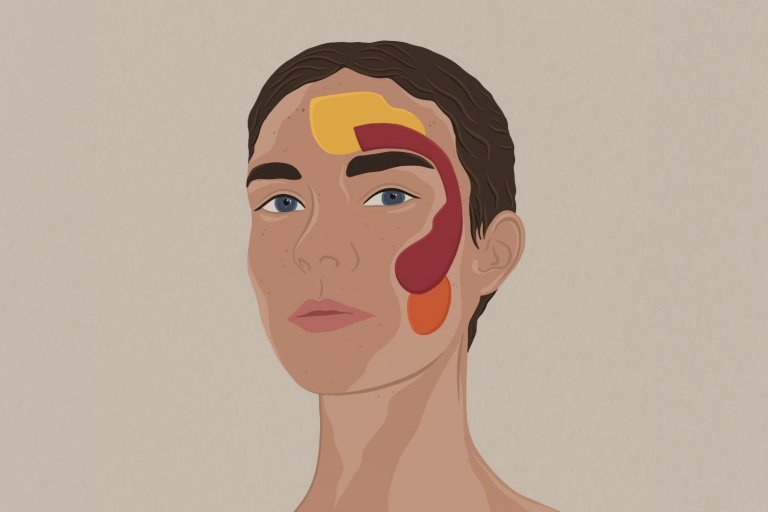When I was eight years old, my mother told me it was inappropriate to wear makeup outside of the house. I had put on some lipstick and eyeshadows, trying to mimic the stage makeup that I wore for shows. What I thought was purely fun, somehow managed to upset her and now, looking back, I would even say offend her. As I got older, the rules seemed to change.
By middle school I was allowed some mascara and maybe a hint of lipgloss. Early high school brought about a goth phase, and thus I discovered the black kohl liner. By graduation, it seemed as if all the rules had been lifted. I had the freedom to wear whatever I wanted on my face, but that freedom was wasted. Still an insecure teen, my thoughts were concerned with looking pretty and to do so, aligning with the beauty standards I was surrounded by. I didn’t want to stand out because the idea that makeup was anything more than a tool— a part of the daily routine to look a certain way— had been well and truly erased from my brain.
When I shared my experience as a child with other women, I found that a resounding majority shared a similar one. This constant reiteration of the same message “makeup is inappropriate for children” seems intertwined within the diverse lives of women. So, I began to question it. What makes makeup inappropriate for children? To its base, makeup is simply a form of paint that we have altered so it won’t unleash life-threatening chemicals into the skin if worn for an extended period of time. How has that become something so villainized that it can draw out such an instinctually negative reaction?
In my journey, I followed the problem to the group of people I thought would be able to give a clear answer, mostly because they seemed to be the biggest proponents of the message in question: mothers. When questioned on the reason and validity behind the seemly ageist viewpoint regarding makeup, I discovered that the rationale projected as concern for “age-appropriate” actions was instead speaking to a more deeply-rooted stigma within society. One mother admitted how her concern with young girls wearing makeup lied not with her own standard of appropriateness, but, instead, her worry of being judged by other mothers. If she allowed her daughter to wear makeup at an age lesser than deemed socially acceptable, what did that say about her as a person, or worse, as a mother?
Another mother clued me in on the underlying notion that truly plagues this idea. When she was questioned, she also referred to the “age-appropriateness” of the matter but she took it a step farther to shed light on fear. Part of motherhood is the instinctual need to protect one’s children whether it be from physical, emotional or mental danger. A large part of this plays to protecting a child’s innocence, which is something that our society has deemed so valuable but views as incredibly fragile. So fragile, in fact, that a smear of paint in the wrong place could shatter it.
It took me a while to wrap my head around the kind of power that makeup holds because I couldn’t understand where it came from. Who was giving it that power? How? The answer is you. And me. And everyone else who has ever looked at another person and made a judgement— conscious or subconscious— about that person simply because of what they wore on their face. Makeup has been saddled with a negative connotation; and, because of that, those who choose to utilize it (to any degree) receive a reputation that directly correlates to how society views their beauty routine. There is judgement for the fullest faces of makeup and at the same time, the barest. A full face of makeup aligns to a high maintenance, insecure or even promiscuous persona but on the opposite end of the spectrum, a bare face equates to sloppy, lazy and unfeminine.
Age, in addition to the amount of makeup worn, determines the kind of judgement received. A child should have a clean face, bare of any makeup, whereas a woman should wear a fuller face to appear more presentable to society. When the roles are reversed— a child fully made up and a grown woman without a scrap— it challenges our social norms. So why is it that a face of makeup on an adult woman is not only considered acceptable, but to a certain degree expected, but we get uncomfortable at the idea of a child doing the same?
In Elizabethan times, noticeable makeup was associated with prostitution, and the over-sexualization of makeup has only solidified over time. Makeup, with its ties to sexuality, is considered to be a more effective way to attract a partner. Such actions strongly go against the innocence that children hold, creating the viscerally negative reaction when the two paths cross.
When considering all of this, I began to understand the truly vicious cycle that is bred through makeup. Wear it, don’t wear it, there will be judgement nonetheless. What I want to know is: is it actually effective to shelter our children from makeup? Doesn’t it carry on the toxic idea if we continue to push the bigger problem under the rug and brush it off with vague reasoning? Instead of being so concerned with the makeup that children want to wear, isn’t it time to trouble ourselves with those who give them a reason not to? If we take away the connotations, makeup simply becomes paint and paint has no age.
Written by Hana Lorne
Illustration by Michelle Parry

